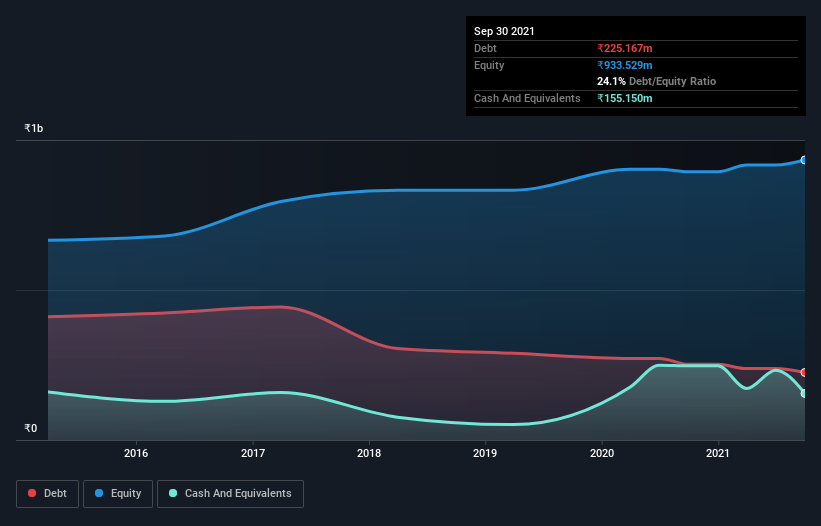These 4 Measures Indicate That Bang Overseas (NSE:BANG) Is Using Debt Reasonably Well

Some say volatility, rather than debt, is the best way to think about risk as an investor, but Warren Buffett famously said that 'Volatility is far from synonymous with risk.' It's only natural to consider a company's balance sheet when you examine how risky it is, since debt is often involved when a business collapses. We note that Bang Overseas Limited (NSE:BANG) does have debt on its balance sheet. But should shareholders be worried about its use of debt?
What Risk Does Debt Bring?
Debt and other liabilities become risky for a business when it cannot easily fulfill those obligations, either with free cash flow or by raising capital at an attractive price. Part and parcel of capitalism is the process of 'creative destruction' where failed businesses are mercilessly liquidated by their bankers. However, a more frequent (but still costly) occurrence is where a company must issue shares at bargain-basement prices, permanently diluting shareholders, just to shore up its balance sheet. By replacing dilution, though, debt can be an extremely good tool for businesses that need capital to invest in growth at high rates of return. When we examine debt levels, we first consider both cash and debt levels, together.
View our latest analysis for Bang Overseas
What Is Bang Overseas's Net Debt?
You can click the graphic below for the historical numbers, but it shows that Bang Overseas had ₹225.2m of debt in September 2021, down from ₹252.2m, one year before. However, because it has a cash reserve of ₹155.2m, its net debt is less, at about ₹70.0m.

A Look At Bang Overseas' Liabilities
Zooming in on the latest balance sheet data, we can see that Bang Overseas had liabilities of ₹341.7m due within 12 months and liabilities of ₹30.6m due beyond that. Offsetting this, it had ₹155.2m in cash and ₹561.2m in receivables that were due within 12 months. So it actually has ₹344.0m more liquid assets than total liabilities.
This surplus liquidity suggests that Bang Overseas' balance sheet could take a hit just as well as Homer Simpson's head can take a punch. With this in mind one could posit that its balance sheet means the company is able to handle some adversity.
In order to size up a company's debt relative to its earnings, we calculate its net debt divided by its earnings before interest, tax, depreciation, and amortization (EBITDA) and its earnings before interest and tax (EBIT) divided by its interest expense (its interest cover). Thus we consider debt relative to earnings both with and without depreciation and amortization expenses.
We'd say that Bang Overseas's moderate net debt to EBITDA ratio ( being 1.9), indicates prudence when it comes to debt. And its strong interest cover of 1k times, makes us even more comfortable. Shareholders should be aware that Bang Overseas's EBIT was down 68% last year. If that decline continues then paying off debt will be harder than selling foie gras at a vegan convention. The balance sheet is clearly the area to focus on when you are analysing debt. But it is Bang Overseas's earnings that will influence how the balance sheet holds up in the future. So if you're keen to discover more about its earnings, it might be worth checking out this graph of its long term earnings trend.
Finally, a company can only pay off debt with cold hard cash, not accounting profits. So we always check how much of that EBIT is translated into free cash flow. During the last three years, Bang Overseas burned a lot of cash. While that may be a result of expenditure for growth, it does make the debt far more risky.
Our View
Bang Overseas's EBIT growth rate was a real negative on this analysis, as was its conversion of EBIT to free cash flow. But like a ballerina ending on a perfect pirouette, it has not trouble covering its interest expense with its EBIT. Considering this range of data points, we think Bang Overseas is in a good position to manage its debt levels. Having said that, the load is sufficiently heavy that we would recommend any shareholders keep a close eye on it. When analysing debt levels, the balance sheet is the obvious place to start. However, not all investment risk resides within the balance sheet - far from it. For example Bang Overseas has 3 warning signs (and 2 which are potentially serious) we think you should know about.
When all is said and done, sometimes its easier to focus on companies that don't even need debt. Readers can access a list of growth stocks with zero net debt 100% free, right now.
Valuation is complex, but we're here to simplify it.
Discover if Bang Overseas might be undervalued or overvalued with our detailed analysis, featuring fair value estimates, potential risks, dividends, insider trades, and its financial condition.
Access Free AnalysisHave feedback on this article? Concerned about the content? Get in touch with us directly. Alternatively, email editorial-team (at) simplywallst.com.
This article by Simply Wall St is general in nature. We provide commentary based on historical data and analyst forecasts only using an unbiased methodology and our articles are not intended to be financial advice. It does not constitute a recommendation to buy or sell any stock, and does not take account of your objectives, or your financial situation. We aim to bring you long-term focused analysis driven by fundamental data. Note that our analysis may not factor in the latest price-sensitive company announcements or qualitative material. Simply Wall St has no position in any stocks mentioned.
About NSEI:BANG
Bang Overseas
Engages in the manufacturing and trading of textile and textile products in India and internationally.
Mediocre balance sheet and slightly overvalued.
Similar Companies
Market Insights
Community Narratives



